photography by Kevin Wing and Jonathan Beck
[This 2010 BMW R 1200 GS Road Test was originally published in the August 2010 issue of Rider magazine]
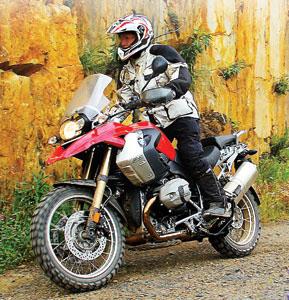
Standing beside the mud-splattered, 2010 BMW R 1200 GS in my garage, I was losing my patience. A friend who races dirt bikes—those skinny, lightweight things with power-to-weight ratios akin to Sidewinder missiles—refused to believe that the big GS can find its way down a dirt road, let alone one that’s been slicked, rutted and puddled by overnight rain. “You rode that in the dirt? It’s not a dirt bike!” Well, of course not. It’s the All-Bike. And it does fine in the dirt; even better on the street. The GS is the rare touring machine that’s as comfortable crawling up a ratty forest road as it is sailing down the freeway. At BMW’s press event near Yosemite in April, it was happy doing both.
The Munich team has been refining the GS since introducing the original R80G/S 30 years ago. For 2010 BMW boosted engine performance and smoothed out its delivery. Radial four-valve heads from the HP2 Sport are the main improvement, but changes ripple throughout the intake system. The new combustion chamber features larger diameter valves—an 8.4 percent increase for the intake and 6.6 percent for the exhaust—which mandated new cast-aluminum pistons. The valves lift a little higher now, with each of the dual cams activating one intake and one exhaust poppet. Upstream, BMW enlarged the throttle bodies from 47mm to 50mm, revamped the intake manifolds and fitted a higher capacity air filter. Two spark plugs per cylinder still ignite the mixture.
The GS appeals to a wide range of riders, from those whose bikes only see gravel in a rustic parking lot to the adventure-minded souls who explore the back-of-beyond at every opportunity. Each extreme has something to celebrate this year: Retuned intake timing for low- to midrange punch for the explorers, and an 8,500-rpm redline, up from 8,000, for the rev-happy crowd. BMW claims a 5 percent horsepower increase to 110 at 7,750 rpm, and a smaller torque bump to 88 lb-ft at 6,000 rpm with the same 1,170 cc displacement and 12.0:1 compression ratio as last year. It also lowered the final drive ratio from 2.82:1 to 2.91:1, so the 2010 could probably pull a plow in a pinch. The engine revs like a turbine when you twist the throttle now—horsepower doesn’t drop till redline, but torque takes a powder shortly after its 6,200-rpm peak. Strangely, although the 2010 bike equaled our 2008 test bike’s output on one run, the average of 12 runs on the Jett Tuning Dynojet dyno has the 2010 bike actually making a little less horsepower peak at the rear wheel, 93 vs. 96, though torque was the same at 73 lb-ft.
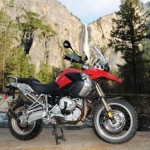
Lug it down or rev it up, the GS suits any style of riding. It didn’t break a sweat while passing six cars and a tanker truck in fifth gear on my ride home from the intro, pulling strongly until that Peterbuilt was a speck in my mirrors. An electronic exhaust flap complements internal silencer mods to add roar-power. There’s no performance gain claimed, but the Boxer’s new high rpm song just might be worth the extra weight and mechanical complexity.
Last year I bought an F 800 GS, reasoning that the 1200 was more than my 145 pounds could handle over hill and dale. Turns out I was wrong. Within two minutes of leaving the hotel for our test ride, we turned onto a soggy dirt road. It was sink or swim with the big dual-sport. The knobbies that BMW had put on all the bikes for the rain-soaked test loop kept the beast planted on the slick surface, helping me conquer whatever the road dished out. My confidence increased with each turn, each rocky section, each slippery rut approached and vanquished. First gear is too low for most traveling and is best saved for steep climbs and tricky pathfinding. Second is a GS rider’s best friend, taking you from slow plonking to 40 mph or more in mere moments, traction permitting. Spin up the rear tire in second or third and the GS will do feet-up power slides until your grin muscles cramp. But with faster travel comes the eventual need to scrub off some speed—you are on top of 538 pounds fully fueled, after all.
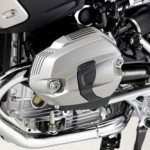
Whatever the surface, the GS binders are excellent. Four-piston calipers squeeze twin 12-inch front discs and a two-piston unit grabs the single 10.4-inch disc at the rear. Two fingers are enough on the pavement; one is plenty on looser surfaces. BMW’s integral anti-lock brakes are an $1,100 option on the GS. Unobtrusive in operation, they’re worth the price if they prevent just one mishap. They certainly helped me breathe a little easier while riding into Yosemite Valley through rain, sleet and snow. But I made a point of disabling the ABS—just come to a stop and push a button —when we hit the dirt, where it can extend stopping distances past the edge of a cliff. The GS model’s heftiness drives home the mass x velocity = momentum equation from Physics 101 when flying down a dirt road. Dakar-level riders will just pitch it sideways in the corners, but those of us hoping to see our next birthday will scrub off some speed and use the throttle to steer the bike through. Besides overshooting a couple of early corners, I only noticed the bike’s weight when pulling it upright off the sidestand.
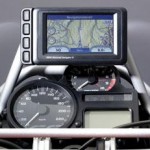

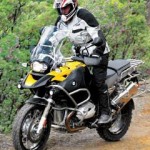







Very great post. I simply stumbled upon your weblog and wanted to mention that I have really loved surfing around your weblog posts. In any case I’ll be subscribing for your rss feed and I hope you write again soon!